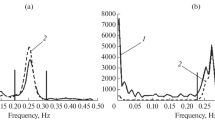Abstract
A large interindividual variability of parameters quantifying respiratory sinus arrhythmia were found in a well defined group of healthy neonates during constant conditions of examination. Reasons for this can be found by means of a mathematical model which is based on physiological data. The results indicate sharp inconsistencies in the transfer function between respiratory movements and resulting respiratory sinus arrhythmia and are dependent on a relative frequency unit fN (ratio of mean respiration rate to mean heart rate). The values of the coherence (as a function of this relative frequency unit) between respiratory movements and heart rate are also distinguished by a systematic decrease from lower to higher fN values (fN=0·1–0·5) and inconsistencies in modelling as well as in physiological examinations. The reasons for both effects can be demonstrated. The study is the basis of a new qualitative step of quantification of respiratory sinus arrhythmia in neonates by power spectral and coherence analyses.
Similar content being viewed by others
References
Ackermann, J. (1961) Über die Prüfung der Stabilität von Abtast-Regelungen mittels Beschreibungsfunktion.Regelungstechnik,9, 467–471.
Bayly, E. J. (1968) Spectral analysis of pulse frequency modulation in the nervous systems.IEEE Trans.,BME-15, 257–265.
Bendat, J. S. andPiersol, A. G. (1971)Random data: analysis and measurement procedures. Wiley-Interscience, New York, London, Sydney, Toronto.
Clauss, G. andEbner, H. (1978)Grundlagen der Statistik, Volk und Wissen, Berlin.
Clynes, M. (1960) Respiratory sinus arrhythmia: laws derived from computer simulation.J. Appl. Physiol.,15, 863–875.
de Boer, R. W. (1985) Beat-to-beat blood-pressure fluctuations and heart rate variability in man: physiological relationships, analysis techniques and a simple model. Thesis, University of Amsterdam.
Harper, R. M., Walter, D. O., Leake, B., Hoffmann, H. J., Sieck, G. C., Sterman, M. B., Hoppenbrouwers, T. andHodgman, J. (1978) Development of sinus-arrhythmia during sleeping and waking states in normal infants.Sleep,1, 33–48.
Holst, E. (1939) Die relative Koordination als Phänomen und als Methode zentralnervöser Funktionsanalyse.Erg. Physiol.,237, 655–682.
Hölzler, E. andHolzwarth, H. (1976)Pulstechnik. Springer Verlag, Berlin, Heidelberg, New York.
Hyndman, B. W. andMohn, R. K. (1975) A model of cardiac pacemaker and its use in decoding the information content of cardiac intervals.Automedica,1, 231–239.
Hyndman, B. W. (1978) Spectral analysis of the cardiac event sequence following mental loading.,2, 171–186.
Koenderink, J. J. andvan Doorn, A. J. (1973) Event train decoders with many inputs, pulse density versus momentaneous frequency.Kybern.,13, 215–222.
Koepchen, H. P. (1977) Neurophysiologische Grundlagen der nervösen Steuerung der Herzfrequenz, insbesondere ihrer atemrhythmischen Schwankungen.Med. und Sport,17, 136–140.
Lohse, H., Ludwig, R. andRöhr, M. (1982)Statistische Verfahren. Volk und Wissen, Berlin.
Musha, T., Takeuchi, H. andInoue, T. (1983) 1/f fluctuations in the spontaneous spike discharge intervals of a giant snail neuron.IEEE Trans.,BME-30, 194–197.
Olsson, T. andVictorin, L. (1970) Transthoracic impedance.Acta Paed. Scand., Suppl. 207.
Oppelt, W. (1960) Über die Anwendung der Beschreibungsfunktion zur Prüfung der Stabilität von Abtast-Regelungen.Regelungstechnik,8, 15–18.
Porges, S. W., Bohrer, R. E., Cheung, M. N., Prasgow, F., McCabe, P. M. andNeven, G. (1980) New time series statistic for detecting rhythmic occurrence in the frequency domain. The weighted coherence and its application in psychophysiological research.Psychol. Bull.,88, 580–587.
Porges, S. W. (1983) Heart rate patterns in neonates: a potential diagnostic window to the brain. InInfants born at risk: physiological perceptual and cognitive processes.Field, T. andStoetek, A. (Eds.), Grune & Stratton, 3–22.
Raschke, F. (1981) Die Kopplung zwischen Herzschlag und Atmung beim Menschen. Thesis, Philipps-University, Marburg.
Richards, J. E. (1985) The development of sustained visual attention in infants from 14 to 26 weeks age.Psychophysiol.,22, 409–416.
Rompelman, O. (1985) Spectral analysis of heart rate variability. InPsychophysiology of cardiovascular control.Orbeleke, J. F., Mulder, G. andvan Doornen, L. J. P. (Eds.), Plenum Press, New York, London, 315–331.
Rother, M., Zwiener, U., Eiselt, M., Witte, H., Zwacka, G. andFrenzel, J. (1987) Differentiation of healthy newborns and newborns-at-risk by spectral analysis of heart rate fluctuations and respiratory movements.Early Human Dev.,15, 349–363.
Weiss, H. R. andSalzano, J. (1970). Formation by whole number ratios of heart rate and breathing frequency.J. Appl. Physiol.,29, 350–354.
Weiss, H. R. andSalzano, J. (1971) Control mechanism of whole number ratios of heart rate and breathing frequency.,31, 466–471.
Witte, H. (1986) Analogverfahren zur Korrektur von Fehltriggerungen bei der Darstellung der momentanen Herzfrequenz.Medizintechnik,26, 15–18.
Witte, H. andSpittel, U. (1987) Signalanalytische Untersuchungen zum reziproken sequentiellen Intervallhistogramm.,27, 36–41.
Witte, H., Rother, M., Glaser, S. andEiselt, M. (1987) Limitation and possibilities of demonstrating nonrespiratory cardiovascular heart rate oscillations in newborn infants. A preliminary report.Automedica,9, 321–330.
Witte, H., Liese, F., Glaser, S. andHoyer, D. (1988a) Results of modelling and physiological examination of movement-related heart-rate reactions in neonates.Med. & Biol. Eng. & Comput.,26, 599–604.
Witte, H., Wagner, H. andMichels, W. (1988b) The application of mathematical modelling to design a data processing system for the evaluation of the state dependence of selected parameters of transfer properties between respiratory movements and heart rate in neonates. A preliminary report.Syst. Anal. Modell. & Simulat.,5, 377–392.
Witte, H., Zwiener, U., Rother, M. andGlaser, M. (1988c) Evidence of a previously undescribed form of respiratory sinus arrhythmia (RSA)—the physiological manifestation of “cardiac aliasing”Europ. J. Physiol.,412, 442–444.
Author information
Authors and Affiliations
Rights and permissions
About this article
Cite this article
Witte, H., Rother, M. Better quantification of neonatal respiratory sinus arrhythmia—progress by modelling and model-related physiological examinations. Med. Biol. Eng. Comput. 27, 298–306 (1989). https://doi.org/10.1007/BF02441489
Received:
Accepted:
Issue Date:
DOI: https://doi.org/10.1007/BF02441489




